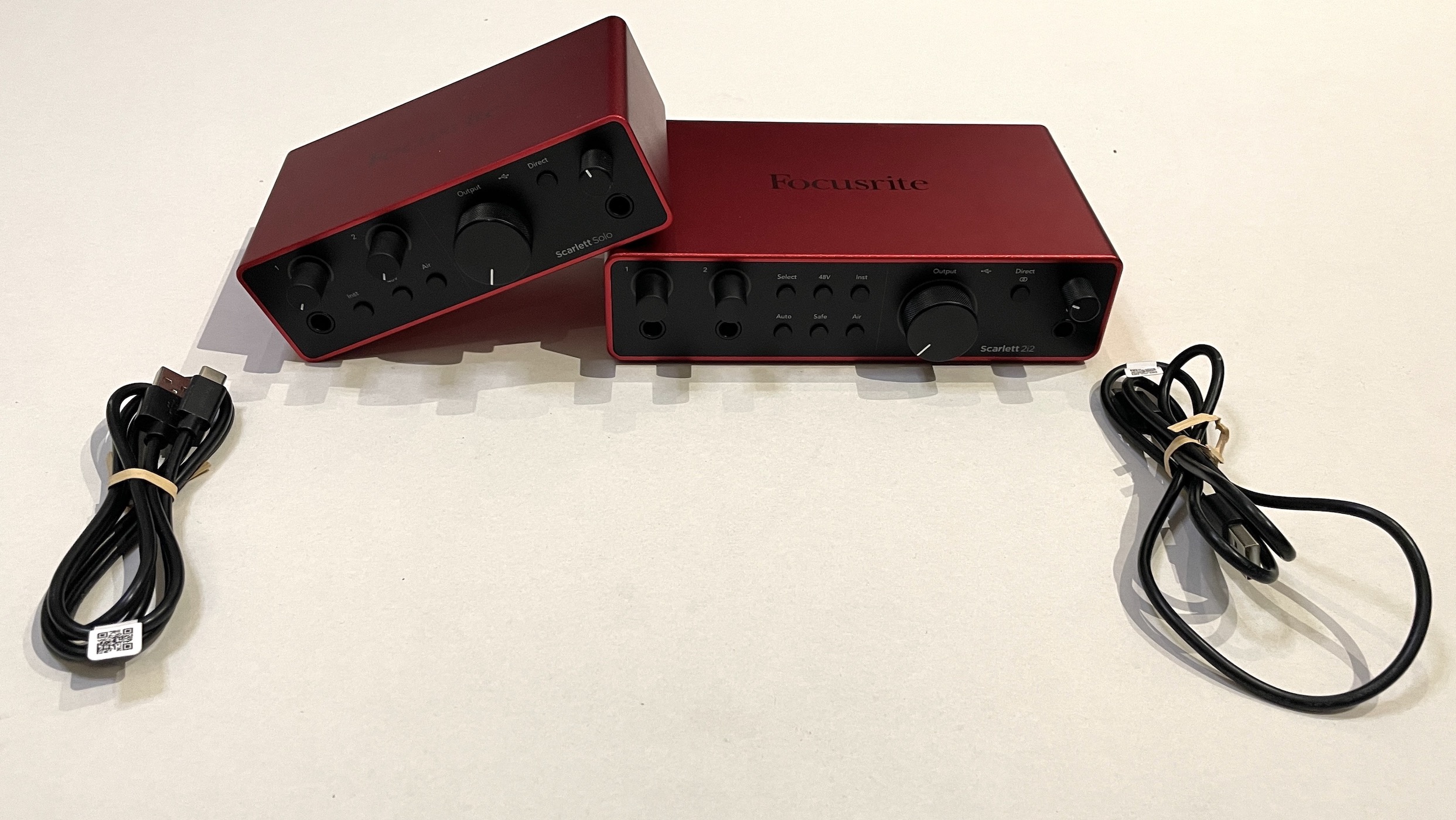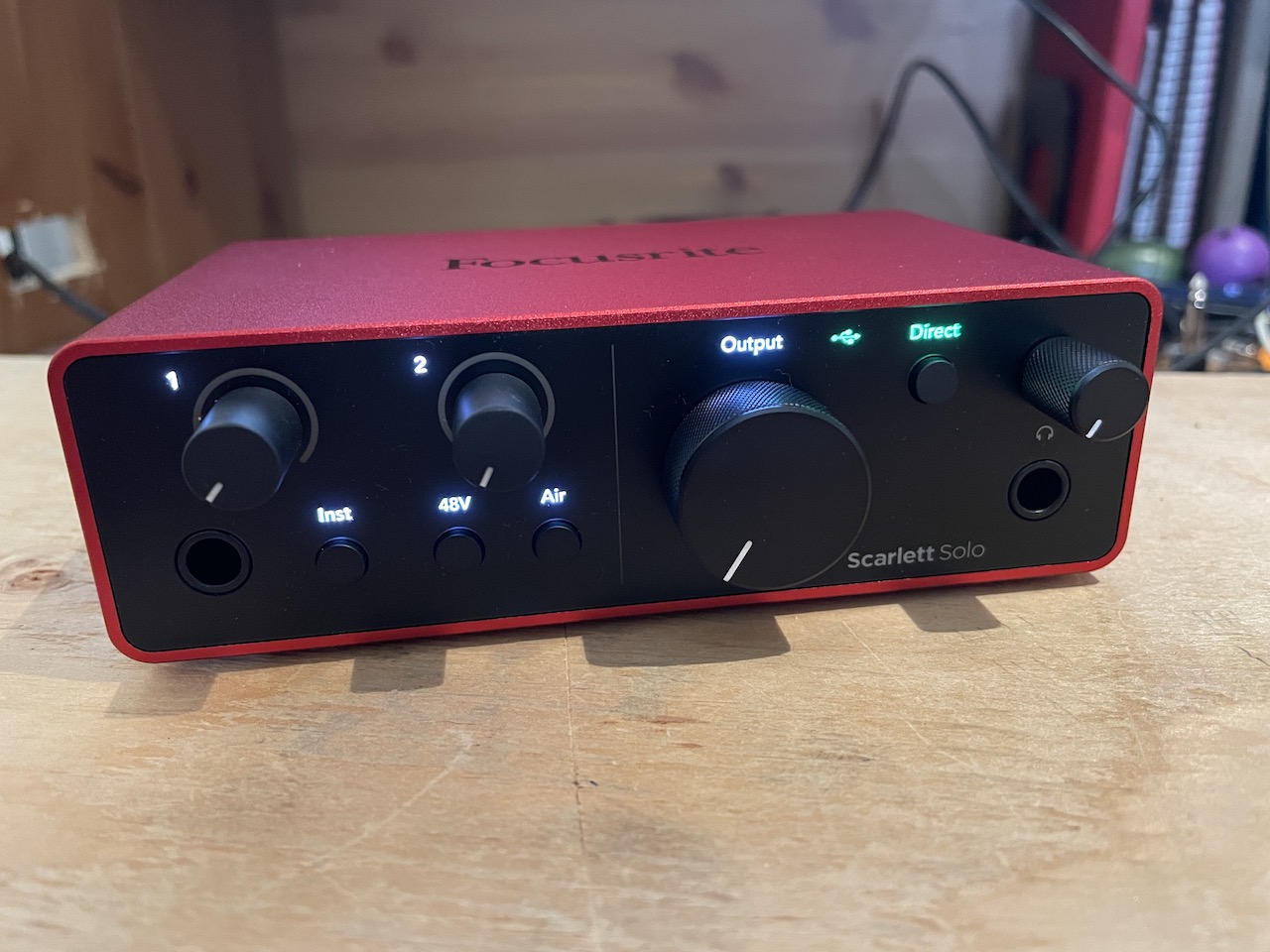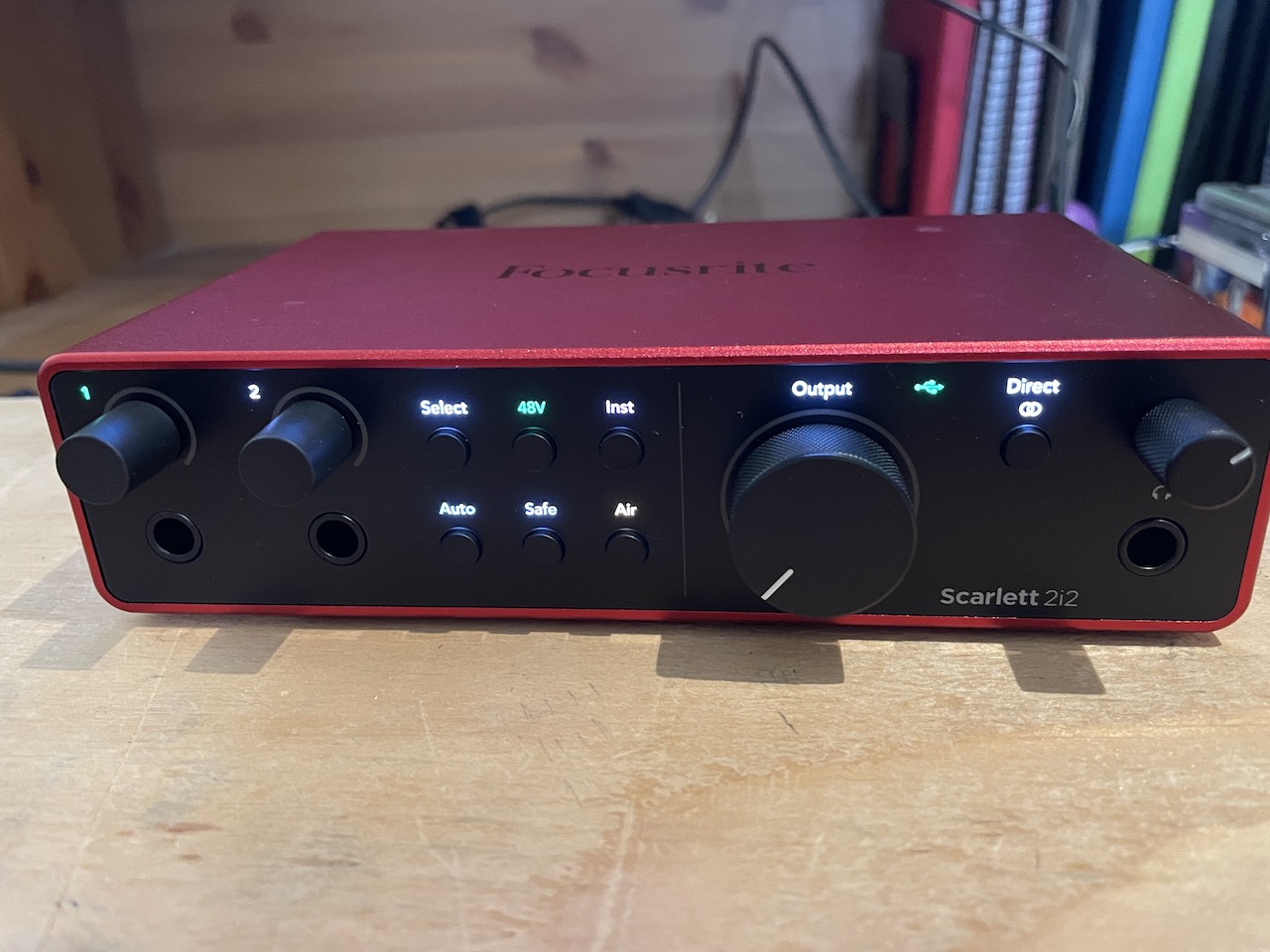
Today I will review the Scarlett Solo and Scarlett 2i2 4th-generation audio interface from Focusrite. The Scarlett series is a very popular audio interface for both beginners and pro users, known for offering a great balance between quality and price. Focusrite improves the value with the 4th-generation edition, offering better component quality and more features than the previous 3rd-generation models.
In this review, I will look at the new features of these Scarlett 4th-generation audio interfaces.

Scarlett Solo and 2i2 are compact and easy to use
The Scarlett Solo and 2i2 offer high-quality sound in a very compact unit. The Solo is impressively small, with a footprint slightly larger than my iPhone 14 mini. The 2i2 is about twenty percent larger than the Solo. Overall these are amazingly compact, making them a great audio interface for travelling musicians. Setup is very easy. I plug in the USB cable and my Mac immediately understands to connect.
The features of the Scarlett Solo and 2i2 are manageable either on the front panel of each unit or via the extremely simple and efficient Focusrite Control 2 app. Personally, I am very happy to see a revised app!
Many similarities, with two important differences

Although these two Scarlett series audio interfaces are quite similar, they differ in two important ways:
- The Solo is aimed at the singer-songwriter. Therefore, Input 1 is a dedicated 1/4″ input for your guitar, and Input 2 is for your XLR microphone cable.
- The 2i2 provides more versatility as both Inputs 1 and 2 are available as either 1/4″ or XLR inputs.
However, the other important difference is also the only downside I can find to share in this review. Whereas the 2i2 features an Auto Gain and Clip Safe feature (more on this later), the Solo does not feature Auto Gain and Clip Safe. Once I discovered how useful Auto Gain and Clip Safe are, I would love for these features to be included in both interfaces.
4th-generation Scarlett has many new recording features
I expected the 4th-generation Scarlett interfaces to contain improvements. Focusrite has done more than enhance existing features, they also leverage features from other products, creating extra (important!) value for users. Here is a quick list of new and improved features:
- Upgraded “Air” Mode
- New Auto Gain and Clip Safe (2i2 only)
- 4th-gen Scarlett preamps
- Improved Audio Conversion
- Improved Dynamic Gain “Halos”
- Revised Headphone Amp
- Line outputs
- Push-button direct monitoring
- TONS of included software
Air Mode adds a new “Drive” element
The first new feature I look at is the Air feature. The Air feature creates a subtle high-end boost (“Presence”), modelled after Focusrite’s outboard analog studio preamps. The 4th-gen Scarlett improves the high-end modelling and also adds a second option that includes saturation (“Drive”), which adds weight and colour to your sound. When I activate “Presence”, I hear a beautiful crispy lift in the high frequencies. Then, when I activate “Presence & Drive” an amazing saturation kicks in, providing a feeling of analog luxury!
The Scarlett Solo features Air Mode only for Channel 2 (XLR), which makes it great for vocals. The 2i2 allows Air Mode to be used on both Channels, providing more flexibility overall.
Auto Gain and Clip Safe are indispensable features
Once you have used the Auto Gain feature, you will wonder how you ever lived without it. My initial interaction with this feature was through Focusrite’s Vocaster podcasting interface, and I am super happy to see they include it with the 4th-generation Scarlett series. However, this feature is limited to the 2i2 interface only. Please take note of this if you are thinking the Solo is going to be your choice.
Setting your gain correctly is probably the most important part of any good recording session. The Auto Gain makes it that much easier. The Auto Gain feature listens to your input for ten seconds, decides how loud (or soft) you are inputting, and sets your input preamp level at around -18db so that you are in the ideal “sweet spot” for recording.
Clip Safe is another feature that you will be happy to have. Even with Auto Gain doing its job, you may have an unforeseen peak during the recording, and the Clip Safe feature can help to manage this for you. Another great add (but only on the 2i2!).
Dreamy 4th-Gen Scarlett preamps
Focusrite preamps have an amazing reputation no matter which of their products you choose. The 4th-gen Scarlett preamps offer 69db luxurious gain, and a total of 116dB. As a beginner or seasoned pro, the preamp is a hugely important part of your recording setup. Having these preamps is simply a “win” for your music. They sound as good as ever! Although the difference may be subtle, the 4th-generation preamps seem to have a little something more to offer.
Additionally, the Scarlett preamps now have 69dB of gain, which is a marked improvement over the 3rd-generation model. If memory serves me well, the preceding model featured 55dB of gain. +14dB is not to be ignored, and with this, the Scarlett now becomes very usable with some of the most popular dynamic microphones on the market. This suggests that the Scarlett can also be used as a podcast audio interface, as well as for standard musical use.
Improved RedNet audio converters
Adding to the sound quality of the Scarlett interfaces are RedNet A/D converters. These are the same converters Focusrite uses in their pro studio A/D interfaces, and they sound amazing. Even more evidence of the great value included with the Scarlett lineup.
Focusrite Scarlett series offers more subtle improvements
The Scarlett Solo and 2i2 audio interfaces have many other improvements. The “Halo” level meters around the gain knobs are improved, offering more detail and also reflecting the use of the Auto Gain feature. The headphone amp also receives an upgrade. It is difficult for me to measure this against 3rd-generation Scarletts, but I can say that this version sounds fantastic, and there is no need to compare.
The Scarlett interfaces also feature push-button direct monitoring, allowing for low-latency use if needed via the button on the front of the interface. Both units feature L/R line outputs for connecting studio monitors.
Both interfaces come with access to a wide selection of software plugins and apps as well. You will find access to DAWs Ableton Live Lite and Hindenburg, a suite of Focusrite audio plugins (the Midnight, Scarlett, and Red series), and many different sound packs and loop packs. There is even access to XLN’s Addictive Keys and Novations Bass Station virtual instruments.
My opinion—incredible value, incredible sound
To conclude my review of the Scarlett 4th-generation Solo and 2i2 audio interfaces, I will say that purchasing a Focusrite Scarlett as your next audio interface is simply a great choice. I only have one downside to comment on, and this is that the 4th gen Solo model does not have the Auto Gain and Clip Safe features. In my opinion, this tilts the scales towards purchasing the 2i2, even if the 2i2 costs more. This is the only downside I can see, as both the Solo and the 2i2 models sound absolutely amazing and are a pleasure to use. Focusrite hits a grand slam with the 2i2 especially, and I strongly recommend this audio interface for your small recording projects!
Which 4th-generation Scarlett audio interface do you like the sound of? Focusrite’s 4th-generation Scarlett Solo and Scarlett 2i2 audio interfaces are available now at Best Buy Canada.




